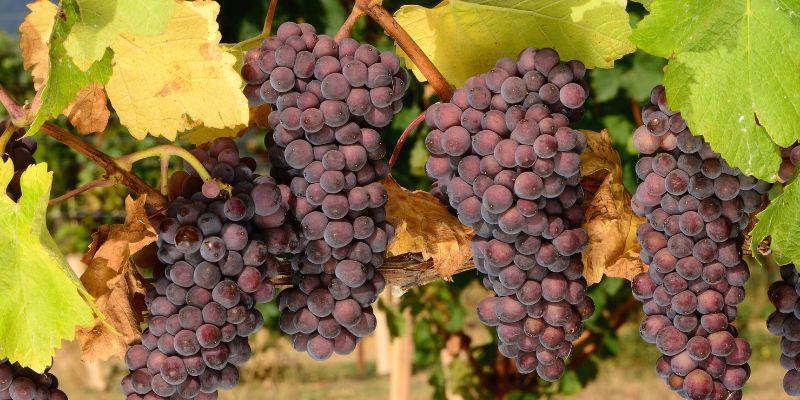Introductory Wine Course
Pinot Noir Primer
Pinot Noir stands as one of wine's most challenging and rewarding varieties, demanding specific conditions and careful handling to express its potential fully. This thin-skinned grape produces wines of extraordinary transparency and elegance, reflecting vintage conditions and site characteristics with unmatched sensitivity. Understanding Pinot Noir requires recognizing how climate, winemaking approach, and regional philosophy create dramatically different expressions, from Champagne's sparkling base wines to Burgundy's profound still reds. Mastering these distinctions enables precise communication about what separates a red Burgundy from simply a wine made from Pinot Noir grapes, improving your ability to guide selections effectively.
Flavor Profile and Weather Pattern Impacts
Pinot Noir's characteristic flavor profile features red fruits including cherry, raspberry, strawberry, and cranberry, often accompanied by earthy notes of mushroom, forest floor, wet leaves, and sometimes floral hints of rose petal or violet. The grape shows remarkable sensitivity to temperature during the growing season, with cool vintages producing lighter-bodied wines emphasizing bright red fruit and higher acidity, while warmer years yield fuller wines with darker cherry and plum notes alongside more pronounced alcohol. Vintage variation matters more for Pinot Noir than for thicker-skinned varieties that ripen reliably across diverse conditions. The grape's thin skin means less anthocyanin and tannin extraction, resulting in lighter color and softer structure compared to Cabernet Sauvignon or Syrah. This delicacy makes Pinot Noir vulnerable to both underripeness, which produces green, vegetal characteristics, and overripeness, which creates jammy fruit that obscures the variety's essential elegance. Ideal conditions provide long, cool growing seasons with warm days and cool nights, allowing gradual flavor development while preserving acidity. Regions like Burgundy, Oregon's Willamette Valley, and California's cooler coastal areas offer these conditions, while warmer sites often struggle to maintain Pinot Noir's finesse.
Pinot Noir is dependent upon the weather it is grown in. A cooler climate will result in a lighter wine, while a warmer climate will ripen the grapes more and the result is more color in the glass and more weight on the palate.
Pinot Noir's Range: Champagne to Red Burgundy
Pinot Noir contributes body, structure, and red fruit character to Champagne blends, providing weight and aging potential that complement Chardonnay's elegance and Pinot Meunier's fruitiness. Blanc de Noirs Champagne, made entirely from Pinot Noir and sometimes Pinot Meunier, showcases the grape's ability to produce complex, full-bodied sparkling wines with brioche, strawberry, and subtle earthy notes despite being vinified without skin contact to maintain pale color. The Montagne de Reims and Aÿ produce particularly renowned Pinot Noir for Champagne. Red Burgundy represents Pinot Noir's ultimate expression, where the grape reveals intricate distinctions between villages, vineyards, and even small parcels within single vineyards. The Côte de Nuits produces the most structured, age-worthy examples from villages like Gevrey-Chambertin, Chambolle-Musigny, and Vosne-Romanée, each showing distinct personalities despite geographic proximity. Gevrey offers power and earthiness, Chambolle provides perfume and delicacy, while Vosne combines elegance with depth. The Côte de Beaune, including Volnay and Pommard, produces slightly softer styles with immediate charm. Burgundian Pinot Noir balances fruit with savory complexity, showing layers that evolve in the glass and develop significantly with bottle age.

Understanding Pinot Noir Versus Red Burgundy
The distinction between varietal Pinot Noir and red Burgundy encompasses fundamental differences in winemaking philosophy, regional expression, and structural approach. New World Pinot Noir, particularly from California, often emphasizes ripe fruit, new oak influence, and immediate accessibility. These wines typically show higher alcohol, fuller body, sweeter fruit impression, and more obvious oak-derived vanilla and toast characteristics. Whole cluster fermentation may add spice notes, while extended maceration extracts more color and tannin than traditional Burgundian methods. The resulting wines offer generous, fruit-forward profiles that appeal immediately. Red Burgundy prioritizes transparency, restraint, and terroir expression over varietal fruitiness. Burgundian producers typically destem grapes completely or use modest whole cluster percentages, ferment in open-top wooden vessels with gentle extraction, and age in older oak barrels that contribute structure without dominating flavor. This approach yields wines with moderate alcohol, lighter color, silky rather than grippy tannins, pronounced earthy and savory characteristics, and firm acidity that demands food or cellar time. Red Burgundy often seems austere or closed in youth, requiring years to integrate and reveal complexity, while many New World Pinots drink well upon release. Understanding these stylistic differences proves essential when matching wines to customer expectations and meal requirements.
Distinguishing between Pinot Noir as a variety and red Burgundy as a terroir-driven wine style enables more sophisticated guidance and accurate descriptions. Recognizing how vintage variation, extraction methods, oak treatment, and regional philosophy shape Pinot Noir's expression allows meaningful communication about style differences, from Champagne's structural contribution through Burgundy's complexity to New World's fruit-forward approachability. This knowledge proves critical when recommending this wine, ensuring your offering align with guest preferences, food pairings, and drinking occasions while building credibility through nuanced, accurate information that respects both the wine and the person selecting it.